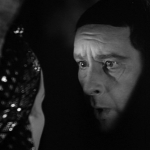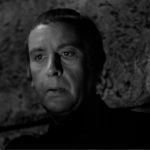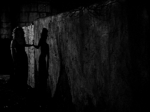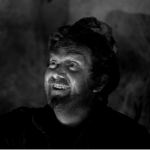So let’s talk about Lighting. Besides the functional side of lighting (i.e. lighting the sets so you can see the sets and actors) there is mood lighting and this is what I’m going to touch on because it’s more fun.
For the most part the movie is pretty tame in the lighting department despite William Dieterle being part the of German Expressionism movement but there is great example of chiaroscuro. Chiaroscuro (Italian for light and dark) utilizes the contrast between light and dark for pure dramatic effect. During the scene where Frollo confesses his confused love/lust for Esmeralda. As he pins her against a tree his face is fully illuminated while the back ground is let darker; text-book Chiaroscuro.
There is a moodiness to certain scenes and sometimes characters would get lighting treatment (i.e softening, harding, bottom lighting or chiaroscuro) but I would say that at the time of the film’s release the lighting came off more dramatic. After all Dieterle was part of the German Expressionism movement which was the predecessor to Film Noire ( which by it’s very nature is moody) so there is mood but for a modern viewer the dramatic isn’t as striking except in the confession scene, that was a slap in the face with lighting.
See ya next time – It’s time for Book vs the 1939 version





